Sometime during the night of November 7th, 2018 the winds shifted over the Sierra Nevada. Winds blowing east from the Pacific were supplanted by winds blowing west out of the Great Basin of Nevada. They gathered strength as they swept down the slopes of the mountains and entered the canyons. By the early morning hours of November 8th, they were gusting up to 50 mph.
In a remote part of the Feather River Canyon seven miles from the town of Paradise, California stood an electrical transmission tower that was almost one hundred years old. According to the electric utility company PG&E, the average life expectancy of a transmission tower was sixty-five years. PG&E knew some of its infrastructure was old and potentially dangerous, which was why it regularly implemented a policy of preemptive electricity shut offs when conditions were hazardous. On the morning of November 8th it decided not to.
Sometime after 6:00 a.m., the wind snapped a hook on the arm of the tower. A live electrical wire fell into the brush. The sizzling sparks ignited a fire. Then the wind spread the fire around like a hand wiping paint across glass.
No Strangers to Fire
The town of Paradise sits on a narrow plateau between two deep canyons, the Butte Creek Canyon on one side and the Feather River Canyon on the other. If the canyons were filled with water, the town would be on a peninsula. There are only three routes out of town.
Paradise had a population of 27,000 on November 8th, 2018. It was a close-knit community that was no stranger to fire. In the decade leading up to 2018, thirteen large wildfires had burned in the surrounding region. In 2008 the Humboldt Fire, which consumed 23,000 acres, actually reached the outskirts of Paradise, although the town was spared. Thus it was that when early risers awoke to the smell of smoke on November 8th no one was particularly alarmed. They fully expected the fire to be put out before it became a problem.
A Problem
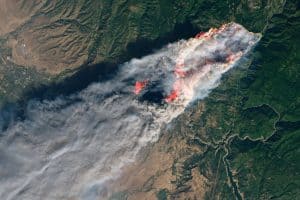
Satellite view of the Camp Fire. 50 mph winds were blowing the convection cloud horizontal to the ground.
In a fire station overlooking the Feather River Canyon a fire chief named Matt McKenzie stepped outside to peer down into the canyon at what looked like smoke . The howling wind snatched the door out of his hand and slammed it against the wall. This was not good.
Down in the canyon, McKenzie spotted what looked like flames. He assembled a crew and drove his fire truck down to put it out, but as he got closer he noticed something concerning, the fire had leaped the river and eaten its way up a narrow defile called Camp Creek Road. The approach was narrow and difficult to turn around in, so rather than take the truck in and risk getting stuck, he phoned for back up. It was around 6:30am. He reported a wildfire on Camp Creek Road. In the interest of expediency, dispatchers shortened the name. They called it the Camp Fire.
Had McKenzie grasped how fast the fire was moving he might have risked everything to stop it. The canyon ascended to the town of Paradise along a series of natural steps. Fifteen minutes after McKenzie made the call, the fire was leapfrogging up the steps and heading straight for the town. In minutes it would be there.
Eerie Sights
Around 6:45am the people of Paradise were emerging from their homes to start the new day. Looking around, they saw some strange sights. A vast flock of birds had filled the sky, streaming west. An eerie darkness was stealing rapidly over the town. And a fine gray snow was falling from the sky, collecting on lawns and cars. Ash.
Around 7:00am fire exploded up out of the canyon in a corona of swirling embers. Swept forward on a howling wind, it hurled flaming chunks of tree limbs and branches before it, what firefighters refer to as firebrands, each one a piece of kindling to start a new fire. At the canyon’s edge, Ponderosa pines and Douglas firs suddenly combusted, shooting flames straight up into the air like Roman candles.
The Feather River hospital was a few hundred yards from the canyon’s edge. In an instant, the roof of the hospital was showered with embers. The sixty-seven patients inside rushed to be evacuated. There was no time to spare. The doctors and nurses loaded them into ambulances. The wind gusted the fire forward like the breath of a dragon. The heat was excruciating.
A Dreadful Situation
Every wildfire generates a column of smoke called a convection column. The column is made up of carbon dioxide, water, burnt matter, and other nasty components such as formaldehyde and acrolein. It can tower 4,000 feet into the air. In the case of the Camp Fire, however, it was driven horizontal to the ground by the roaring winds. Anyone standing in its path was blasted by it, as were the medical personnel and patients from the Feather River hospital.
A convection column also carries firebrands, scattering them near and far, and not in a straight line. The convection column in Paradise spawned at least one fire tornado, a rotating column of superheated air that whirls around spewing firebrands all over the place, igniting random spot fires in every direction.
Normally, a wildfire advances zone by zone, moving forward in a sequential manner, but the fire in Paradise was hop-scotching back and forth, side to side. As spot fires ignited, they spread and merged, surrounding the firefighters, who were just arriving, and cutting off their escape routes. As the firemen advanced toward the fire, they often found a new fire suddenly behind them. It was a dreadful situation, the fire was out of control, and the residents of Paradise had only just begun to evacuate.
Monster
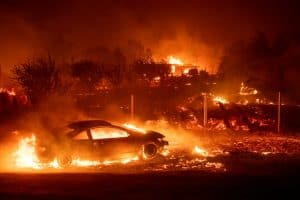
The fire was a monster. In some areas radiant heat reached 1,500 degrees, the temperature of a crematorium.
Paradise had an evacuation plan with an early alert system in place, but there were two problems with it. The fire was moving so fast it burned down powerlines and knocked out cell service before authorities could get the word out. Also, the alert system had been opt-in, meaning residents had been required to sign up to receive the warnings. Less than half had. Of the town’s 27,000 people only 6,200 received official warning to evacuate. The rest were left to figure it out on their own.
By 8:00am, as residents converged on the the three roads leading out of town, firefighters streamed in. They came from all over, from Chico and Oroville, from Yuba City and Grass Valley. By the time they set up and got organized, the fire was a monster. In some areas radiant heat had reached 1,500 degrees Fahrenheit, the temperature of a crematorium. By 9:00am the fire was consuming major buildings. The Safeway was burning. The Adventist church was up in flames. Coffee shops, antique stores, mobile home parks, gas stations. What had started as a rural fire in the country was now an urban fire in the city.
Fleeing vehicles created a massive traffic jam as the fire leaped past them and swirled around them. The ambulances from Feather River hospital got stuck in the snarl. As the heat grew unbearable, doctors and nurses abandoned the ambulances, carrying patients by hand to a nearby house. Working frantically, they created a fireline by clearing brush from around the building and hosing down the roof. Then they hunkered down and prayed.
No Good Choice
Those who remained in their cars were faced with a horrible dilemma. As the fire whipped and swirled around them, they could stay where they were and risk being incinerated, or try to escape on foot ahead of a fast moving blaze that could cut off their escape route and trap them. Some panicked and gunned their engines, colliding with other vehicles, further snarling traffic. Others jumped out and ran.
Neither choice was good. Those who stayed in their cars witnessed their tires and grillwork melting. The windows and door latches grew too hot to touch. Those who fled found themselves immersed in thick, dark smoke, the ground aglow like the jumbled spill of an exploding volcano. Burning embers swirled and darted before their eyes, flames licked up around them. The bang, bang, bang of exploding propane tanks could be heard through the roar of the fire.
Defensive Positions
Near the Fastrip gas station at the intersection of Skyway and Clark, firefighters shouted at residents to abandon their vehicles, and then formed a makeshift wagon circle using their firetrucks to protect them. But it was a bad location. The Reliance Propane yard was nearby. Directly across the street was Fins, Fur and Feather, a sporting goods store full of live ammunition. And on the other side of the street was the Fastrip gas station full of combustible fuel.
Seeing the potential disaster, quick thinking firefighters abandoned the encircling strategy and broke into a cluster of tin-roofed buildings a block away. They shepherded the residents inside. Then they watered the buildings down to keep the fire from igniting them. In another part of town, a similar strategy was in play as firefighters formed a cordon around citizens, then stood aiming their hoses outward like armed soldiers defending a position against attack.
A Strange New World
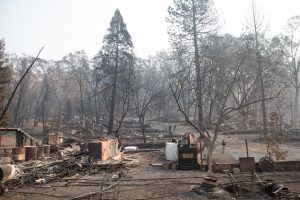
A black and white landscape of charred wood, twisted metal, and gray ash was all that remained of much of the town
Five hours later, the worst was over. Much of the traffic had dissipated, and a way had been opened for residents to evacuate. Those inside the tin-roofed buildings were turned out and told to drive away in whatever vehicles remained. The medical personnel and patients from Feather River hospital emerged shaken and were borne away on firetrucks.
A look around revealed a strange new world, a black and white landscape of charred wood, twisted metal, and gray ash. The burned out hulks of automobiles were scattered across the roadways. Inside some, the skeletonized remains of the drivers could be seen hunched over steering wheels.
The fire raged on. While the fire in Paradise had been brought under control, the wildfire kept moving, consuming over 200 square miles before it was finally put out seventeen days later. The devastation was immense. 18,804 homes, businesses and other structures had burned to the ground. More than 50,000 people had been displaced. Eighty-five people lost their lives.
If there was a silver lining to any of this, it was the generosity of strangers, people from all over the world who came forward to donate food, clothing and medical supplies on a scale so overwhelming that shelters and drop off locations had to ask them to stop.
But if some people were big hearted, others were conspicuously absent with their generosity, notably the company that had caused the fire in the first place, PG&E.
One Company’s Deplorable Track Record
From the start PG&E was evasive. Right after the fire, PG&E announced there had been “no determination on the causes of the Camp Fire”, even though it had already provided a report to the California utilities regulator that it had observed damage on one of its towers that might have sparked the blaze. Clearly, the company was buying time. It knew it was probably to blame and was staring down the barrel of a huge liability. PG&E was no stranger to huge liabilities.
In the decade leading up to the Camp Fire, PG&E equipment was found to have caused at least 1,500 blazes across California. At the time of the fire, PG&E was already under federal supervision for criminal violations of safety regulations in the San Bruno pipeline explosion of 2010, which had killed eight. In that instant, a 2011 investigation found the company’s safety efforts lacking. Another audit was more pointed. It found that PG&E deferred maintenance projects to increase its profits. Anyone familiar with the company could’ve guessed what was coming next.
Feathering its Own Nest
On January 29th, 2019, two and a half months after the Paradise fire, as lawsuits mounted, PG&E declared bankruptcy, but not before rewarding its CEO, Geisha Williams, with a $2.5 million severance package and giving its workers $130 million in performance bonuses. When it came to rewarding itself, PG&E was not tightfisted. In the five years leading up to the Paradise fire, PG&E had paid $4.5 billion in dividends to shareholders. But when it came to paying to safeguard its customers, it routinely cried poor.
When outraged judge William Haskell Alsup upbraided the utility for its role in starting wildfires across California and demanded to know why they couldn’t maintain their power lines properly, the utility argued that to do so would require between $75 billion and $150 billion in additional funds, which would result in a substantial rate increase for ratepayers. The Camp Fire had caused $16.5 billion in losses. In the immediate aftermath, the best PG&E could do was to temporarily suspend billing.
It does beg the question, Why doesn’t PG&E just bury its power lines? Doing so would remove the most conspicuous cause of these fires, outdated infrastructure that drops live wires into combustible underbrush. The cost of clearing the areas around suspended wires and of replacing archaic towers is never ending. Why not just put the whole system underground and be done with it? PG&E’s answer: It would cost too much.
Weighing the Costs
PG&E estimates that undergrounding 81,000 miles of distribution lines across the state would cost $3 million per mile, a total of $243 billion. They are quick to add that such an expense would add $15,000 to each customer’s bill, as if the entire cost could only be borne by the ratepayers.
Yet PG&E has already shelled out more than $150 million in fines and legal settlements due to fires caused by its negligence, and that amount doesn’t include the $947 million in firefighting costs paid by the state of California each year. Nor does it include the cost of the Paradise fire where PG&E eventually settled with the town of Paradise and Butte County for $569 million, after mitigating its losses through bankruptcy. Nor does it include the $13.5 billion paid out to individuals across California to cover the cost of fires caused by the poor maintenance of its power lines.
Added together with the $4.5 billion in dividends paid to its shareholders, and the bonuses and severance paid to its executives and workers, the utility has already shelled out close to $20 billion. Rather than paying this out after disasters have struck and lives have been lost, why not pay it upfront as a preventative measure to bury power lines in the state’s most fire prone regions? The answer is as disheartening as it is obvious.
Burned: The Fire that Destroyed Paradise
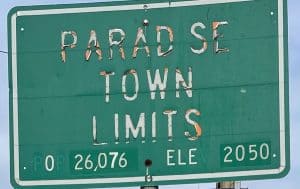
Paradise town limits sign with lettering that was peeled by the intense heat
The first consideration of any investor-owned publicly traded utility must be profit. Undergrounding lines would require a short-term loss, and shareholders wouldn’t like that. Better the company should return again and again to the tried and true strategy of privatizing profits and socializing losses, rewarding shareholders when the company does well and pushing the costs off onto taxpayers by declaring bankruptcy when the company does poorly.
In the meantime, California will burn. And the residents who lose everything as result will take a backseat to the powerful utility and its investors, whose profits take precedence over everything.
In a classic example of nailing the barn door shut after the horses have run off, PG&E is now undergrounding power lines in the area around Paradise. Laughably too little, too late. But a little something for a beleaguered community that has already gotten burned in more ways than one.
Previous Stop on the Odyssey: The Golden Chain Highway, CA
Next Stop on the Odyssey: Leavenworth, WA
My American Odyssey Route Map
Sources
Bliss, Laura. “The Price of Saving Paradise.” Bloomberg City Lab. 25 August 2020. Website
Blunt, Katherine and Russell Gold. “PG&E Knew for Years its Lines Could Spark Wildfires, and Didn’t Fix Them.” The Wall Street Journal. 10 July 2019. Website
Gee, Alistair and Dani Anguiano. Fire in Paradise, New York, NY, W.W. Norton & Company, May 5, 2020.
Wilson, Janet. “Why not bury California’s fire-prone power lines underground? The reason is sky high.” Desert Sun. 11 October 2019. Website
Image Credits
Firefighter battling a raging wildfire, by Jack Moreh
Burnt out car and gas station, Malcolm Logan
Feather River Canyon, Malcolm Logan
Satellite view of Camp Fire, Coordenação-Geral de Observação da Terra/INPE
Feather River Hospital Emergency Entrance, Public Doman
Fireball and flag, Public Domain
Monster fire, Stormelemental13
Flames seen from a car, Chrisks92
Firefighter with a hose, DVIDSHUB
The ashes of a house in Paradise, Public Domain
National guardsmen by a burnt out car, The National Guard
Fire devastation, Malcolm Logan
Forest Service Investigation Team Investigates Fire Damage, Public Domain
Paradise town limits sign, Malcolm Logan

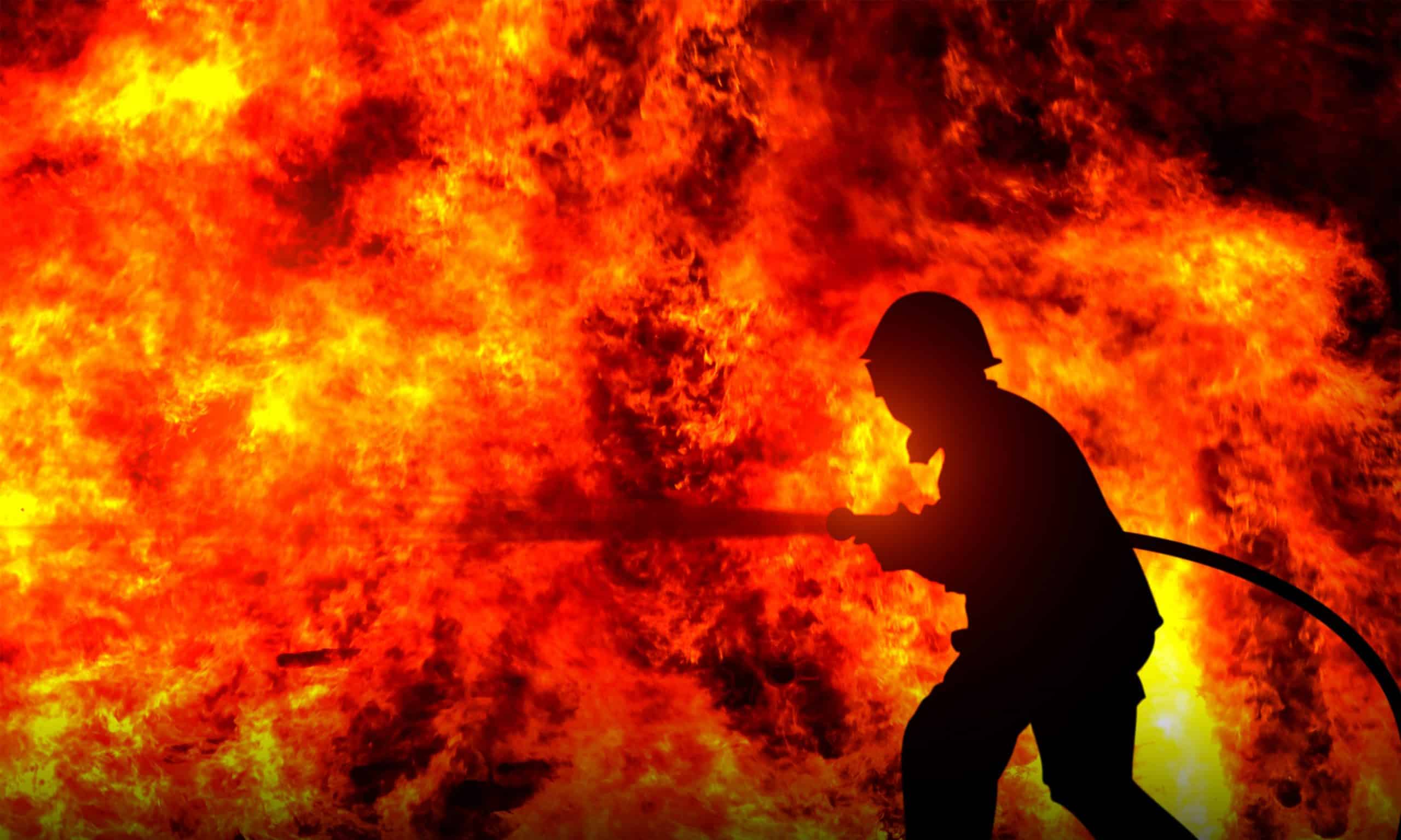
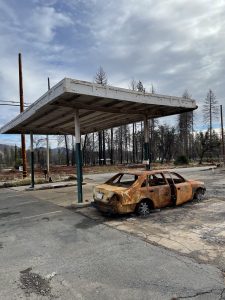
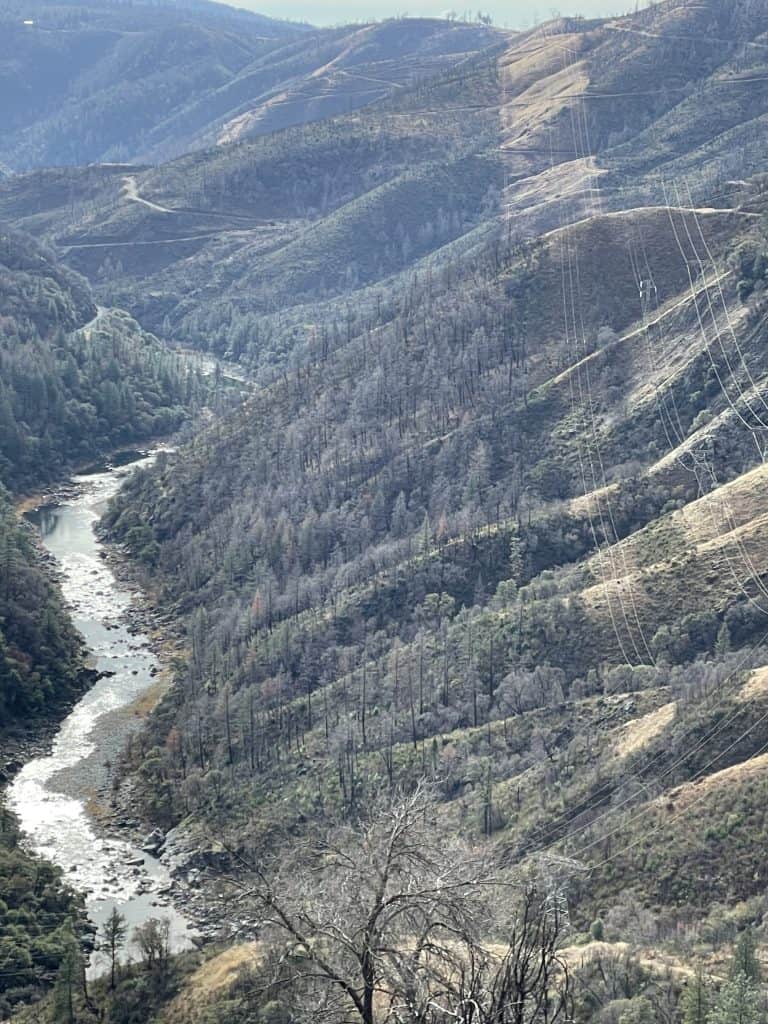
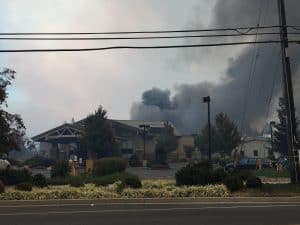
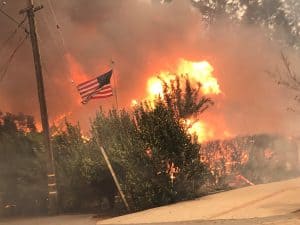
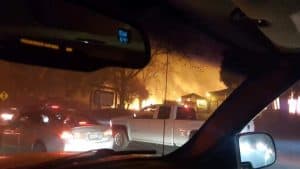
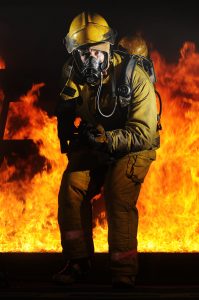
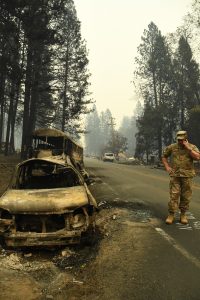
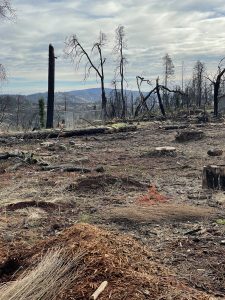

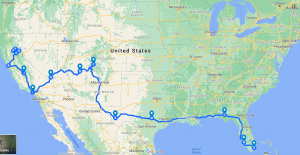
3 comments
Wonderful writing and great story.
What a tragedy, and a little too close to home for comfort.
Sad. Even reading about these fires brings tears to my eyes. It is truly traumatizing to live through… even from the sidelines.